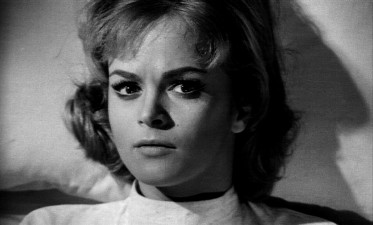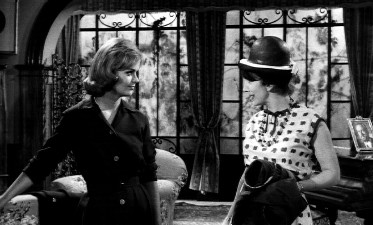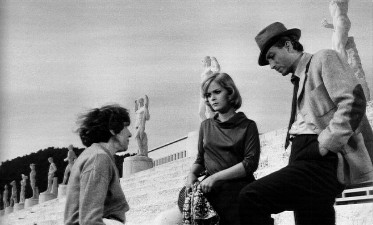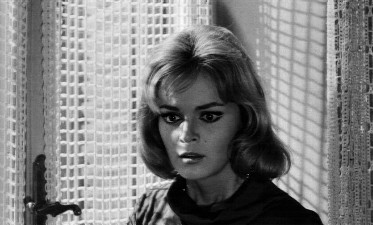














































































































































|
Back To Film Reviews Menu
 |
LA RAGAZZA CHE SAPEVA TROPPO (1962)
Director/Cinematographer: Mario Bava
Story and Screenplay:
Ennio De Concini, Bruno Corbucci, and Eliana De Sabata, with the collaboration of Mario Bava, Giorgio
Prosperi, and Mino Guerrini
Camera Operator:
Ubaldo Terzano
Editing: Mario Serandrei
Music: Roberto Nicolosi (U.S. version rescored by Les
Baxter); Song "Furore," performed by Adriano Celentano
Main Players: Leticia Román (Nora Drowson); John Saxon (Dr. Marcello Bassi); Valentina Cortese (Laura Craven-Tierani); Gianni Di Benedetto (Professor Craven-Tierani); Jim Dolen (Priest);
Lucia Modugno (Nurse); Luigi Bonos (Hotel Porter); Chana Coubert (Aunt Ethel); Dante Di Paolo (Andre Landini); Gustavo De Nardo (Inspector)
Alternate titles: The Girl Who Knew Too Much; Evil Eye (Re-edited English language version)
Aspect ratio:
1.85:1 |
SYNOPSIS:
Part dark comedy, part suspense thriller and part slasher film (though
that term did not come into being until much later, even after Bava
literally creates the genre in SEI DONNE PER L'ASSASSINO), LA RAGAZZA
tells of Nora, a sexually frustrated American girl who journeys to Italy
to visit her elderly Aunt Adele.
 Arriving at her aunt's house following a distressing incident at the air port -- a man who befriends her on the flight is arrested for smuggling
marijuana -- Nora is greeted by Dr. Marcello Bassi. Marcello warns Nora
that her aunt is very ill, and that she needs absolute quiet and rest.
After giving her instructions in case of an emergency, Marcello leaves.
Nora is obviously smitten with him, and her comic ruminations on why he
greeted her by kissing her hand ("I guess he has to kiss my hand since
hes's an Italian") reveals her naďveté. Arriving at her aunt's house following a distressing incident at the air port -- a man who befriends her on the flight is arrested for smuggling
marijuana -- Nora is greeted by Dr. Marcello Bassi. Marcello warns Nora
that her aunt is very ill, and that she needs absolute quiet and rest.
After giving her instructions in case of an emergency, Marcello leaves.
Nora is obviously smitten with him, and her comic ruminations on why he
greeted her by kissing her hand ("I guess he has to kiss my hand since
hes's an Italian") reveals her naďveté.
That same night, aunt Ethel dies of a heart attack, an act witnessed by Nora.
After trying to phone Marcello, Nora flees the house in a panic. While
running through the streets, she is attacked by a purse snatcher. In
the ensuing struggle with the thief, Nora is knocked unconscious. A few
hours later, she is awakened by a woman's scream. To her horror, Nora
looks up and sees a woman collapsing to the ground, a knife in her back.
She also sees a strange man crouching over the body. Nora then faints.
The next morning, Nora is discovered by a passing stranger, who attempts
to awaken her by giving her some whiskey. Noticing that a policeman is
appraching, the stranger flees. The policeman successfullt revives
Nora, but the smell of liquor on her breath causes him to think that she
is an alcoholic sleeping off a drunk. Ranting and raving about seeing a
murder, Nora is shocked to discver that there is no body to be found.
She is then amitted to a hospital for delirium tremors. Bava amusingly
chronicles Nora's brief stay at the hospital, obviously poking fun at
Hitchcock's favored situation of a man or a woman whose identity is
grossly misinterpreted. Nora is rescued by Marcello, who happens to
notice her while on one of his rounds.
 After she is released from the hospital, Nora tells Marcello about what she saw. He is skeptical, preferring to believe that it was an
hallucination brought on by the double shock of her aunt's death and the
subsequent attack of the purse snatcher. Even so, Nora is convinced of
what she saw and refuses to give up. After she is released from the hospital, Nora tells Marcello about what she saw. He is skeptical, preferring to believe that it was an
hallucination brought on by the double shock of her aunt's death and the
subsequent attack of the purse snatcher. Even so, Nora is convinced of
what she saw and refuses to give up.
After the funeral services for her aunt, Nora meets Laura
Craven-Tierani. Laura inroduces herself as a friend of Adele's, and she
takes Nora to her house for some coffee. As she is going out of the
country in a few days, so that she can visit her husband, Laura
encourages Nora to stay and look after her house. Nora is initially
reluctant, but her apprehension about returning to her aunt's house
causes her to accept the offer.
During her first night at the house, Nora discovers a pile of old
newspaper clippings. The articles all deal with a series of killings,
including the brutal murder of Laura's sister. The articles state that
Laura's sister, Emily Craven, was the latest in a string of "Alphabet
Killings" (i.e., the first victim's last name began with the letter A,
the second with the letter B, and so on). These facts cause Nora to
suspect that, since her last name is Drowson, she might be the next
target. Noticing that the articles were written by Andre Landini, she
decides to seek out the journalist for assistance.
 After several unsuccessful attempts at locating Landini, Marcello takes Nora to the beach for relaxation. Marcello's desires finally erupt and
he practically forces himself on Nora. Though she is also interested in
him, Nora encourages Marcello to wait for a more appropriate time to
consummate their relationship. Upon their return to the Craven house,
the are shocked to find a stranger waiting for them in the living room,
The stranger is none other than Landini. He explains that he became
obsessed with fining the Alphabet Killer, and that he collaborated with
the police while writing articles on the killings. When the police
arrested and convicted a man whom Landini knew to be innocent, he
continued writing articles, using them as an opportunity to criticized
the police. He lost his job as a result of this, but he has continued
his investigation. Landini also explains that he was the one who tried
to revive Nora with whiskey, and that he believes her to be the most
likely target for the killer. For this reason, he has been following
her ever since. Though Marcello does not trust Landini, Nora agrees to
collaborate with him. After several unsuccessful attempts at locating Landini, Marcello takes Nora to the beach for relaxation. Marcello's desires finally erupt and
he practically forces himself on Nora. Though she is also interested in
him, Nora encourages Marcello to wait for a more appropriate time to
consummate their relationship. Upon their return to the Craven house,
the are shocked to find a stranger waiting for them in the living room,
The stranger is none other than Landini. He explains that he became
obsessed with fining the Alphabet Killer, and that he collaborated with
the police while writing articles on the killings. When the police
arrested and convicted a man whom Landini knew to be innocent, he
continued writing articles, using them as an opportunity to criticized
the police. He lost his job as a result of this, but he has continued
his investigation. Landini also explains that he was the one who tried
to revive Nora with whiskey, and that he believes her to be the most
likely target for the killer. For this reason, he has been following
her ever since. Though Marcello does not trust Landini, Nora agrees to
collaborate with him.
The following day, Nora goes to meet Landini at his apartment. She is
perplexed to find that the sounds of typing emanating from his room are
actually being played on a tape recorder, and when she finds a photo of
herself labeled as "Fourth Victim," she becomes convinced that he is the
murderer. However, the matter seems to resolve itself when she finds
Landini's body, an apparent suicide, with a note of confession by his
side.
That same night, Laura returns. Nora and Marcello plan to go to the
United States the following morning, and Nora agrees to spend one more
night in the Craven house. That night, when Laura is apparently out,
Nora notices that the study door is open. Especially since Laura had
earlier remarked on how her husband insists that it be kept locked, Nora
cannot resist the temptation to investigate. Upon opening the door,
Nora sees a man rising uncomfortably from a chair. He then collapses to
the floor, a knife in his back. Nora attempts to flee, but is stopped
by Laura. Crazed with anger, Laura confesses to the killings, revealing
that the entire "alphabet system" was a hoax intended to detract
attention from her real motive: the desire to acquire her sister's money
compelled her to murder. However, the thrill of killing has become too
great, and Laura can no longer control herself. Before she can act
again, however, she is shot to death by her dying husband, whom she
murdered when he threatened to turn her over to the police.
 The film ends with Marcello and Nora being happily reunited. Marcello asks Nora for a cigarette, but after she gives him one, she is reminded
of an important incident. On her flight to Rome, she had accepted a pack
of cigarettes from the man who was subsequently arrested for smuggling
marijuana. On the night of her aunt's death, she had accidentally
smoked one of these cigarettes. Consequently, she had interpreted the
situation incorrectly. Though she witnessed an actual killing, her
blurred memory confused the facts. The man she had seen at the scene of
the crime was Laura's husband, but he was not the killer, as she had
previously maintained -- he was merely disposing of the evidence. When
she comes to realize this, she crushes Marcello's cigarette and tosses
the pack over the balcony. They are picked up by a passing priest. The
End. (The American version concludes with Nora promising Marcello that
she will never mention that subject of murder again. As she promises
this, an enraged man shoots his girlfriend and her lover to death. The
act is witnessed by Nora, who acts oblivious to the incident in order to
please Marcello). The film ends with Marcello and Nora being happily reunited. Marcello asks Nora for a cigarette, but after she gives him one, she is reminded
of an important incident. On her flight to Rome, she had accepted a pack
of cigarettes from the man who was subsequently arrested for smuggling
marijuana. On the night of her aunt's death, she had accidentally
smoked one of these cigarettes. Consequently, she had interpreted the
situation incorrectly. Though she witnessed an actual killing, her
blurred memory confused the facts. The man she had seen at the scene of
the crime was Laura's husband, but he was not the killer, as she had
previously maintained -- he was merely disposing of the evidence. When
she comes to realize this, she crushes Marcello's cigarette and tosses
the pack over the balcony. They are picked up by a passing priest. The
End. (The American version concludes with Nora promising Marcello that
she will never mention that subject of murder again. As she promises
this, an enraged man shoots his girlfriend and her lover to death. The
act is witnessed by Nora, who acts oblivious to the incident in order to
please Marcello).
CRITIQUE:
"Though not the first thriller to be made in Italy (that honor seems to
belong to CORTOCIRCUITO, 1943, directed by Giacomo Gentilomo), LA
RAGAZZA was nevertheless the first to introduce explicitly horrific
aspects to the proceedings and, as such, can be considered the true
starting point of the giallo. Though an efficient, stylish and enjoyable mystery-thriller, LA RAGAZZA
CHE SAPEVA TROPPO nevertheless shies away from the more disturbing
aspects of the giallo film. In his later thrillers, Bava stocks the
narrative with sordid, untrustworthy characters and emphasizes irony and
a strain of disturbing, reflexive psychology over the basic mechanics of
mystery plotting. With his next giallo, SEI DONNE PER L'ASSASSINO, Bava
finally pushes the idea of voyeurism (an idea explored for the first
time by Bava in this film) the kind of chilling, intensely personal
treatment it needs. By contrast, LA RAGAZZA is merely interested in
keeping the viewer guessing -- it is a more superficial enterprise in
every sense. At the end of it all, marks a true starting point. It is
a watershed movie, but it lacks the brilliance of the director's best
work.
 The American version, again altered by AIP, is significantly different from Bava's original cut. In addition to substituting Roberto
Nicolosi's original score in favor of a Les Baxter soundtrack, added
comedic scenes (including a rare cameo by Bava, which is not present in
the European edition) render the overall tone much lighter. An
important plot point is also dubbed out of existence since it deals with
the too-hot-to-handle subject of marijuana! Bava had no input in the
final assembly of this version -- known as EVIL EYE -- and so it can be
claimed that this edition is not a genuine Mario Bava film. The American version, again altered by AIP, is significantly different from Bava's original cut. In addition to substituting Roberto
Nicolosi's original score in favor of a Les Baxter soundtrack, added
comedic scenes (including a rare cameo by Bava, which is not present in
the European edition) render the overall tone much lighter. An
important plot point is also dubbed out of existence since it deals with
the too-hot-to-handle subject of marijuana! Bava had no input in the
final assembly of this version -- known as EVIL EYE -- and so it can be
claimed that this edition is not a genuine Mario Bava film.
Bava's obsession with surface appearance is evident throughout LA
RAGAZZA. Nora's naďveté makes her suspect all men of being dangerous.
In her paranoid mind, only women can be trusted. Bava delights in
deflecting these paranoid prejudices by revealing the killer to be
Laura, while Nora is rescued at the end by Laura's dying husband, the
man whom she had believed to be the murderer. The sunny, idyllic city
of Rome, with its history of artistic innovation and romance, seems to
be the safest place in the world -- particularly to a naive American
like Nora. This is yet another view point which is shattered by the end
of the film. As Nora discovers, not all men are evil, nor can all women
be trusted. Likewise, the people of Rome are just as capable of
violence as anybody else, and the city itself takes on a dark, noir-ish
cast.
 In addition to being the starting point of the giallo, LA RAGAZZA is one of the relatively few noir films to have emerged from Italy. At a time
when Bava was embracing widescreen color photography, this film finds
him working in the monochromatic mode for the last time.
Uncharacteristically for Bava, the director makes use of many natural
location shots. Bava's sense of darkly ironic humor comes through most
effectively in this sense. Rather than presenting the usual,
picture-postcard image of Rome, Bava emphasizes the city's darker and
more foreboding aspects. Many exterior scenes take place at night. The
use of backlighting helps to emphasize the shifting forms of shadowy
figures as they steal through the night. Above all else, LA RAGAZZA
succeeds in presenting Rome as a foreboding underworld, where violence
can erupt at random. This approach can also be seen in SEI DONNE PER
L'ASSASSINO, a superior work which brings the giallo into its own by
focusing on sordid characters who live by greed and violence. In addition to being the starting point of the giallo, LA RAGAZZA is one of the relatively few noir films to have emerged from Italy. At a time
when Bava was embracing widescreen color photography, this film finds
him working in the monochromatic mode for the last time.
Uncharacteristically for Bava, the director makes use of many natural
location shots. Bava's sense of darkly ironic humor comes through most
effectively in this sense. Rather than presenting the usual,
picture-postcard image of Rome, Bava emphasizes the city's darker and
more foreboding aspects. Many exterior scenes take place at night. The
use of backlighting helps to emphasize the shifting forms of shadowy
figures as they steal through the night. Above all else, LA RAGAZZA
succeeds in presenting Rome as a foreboding underworld, where violence
can erupt at random. This approach can also be seen in SEI DONNE PER
L'ASSASSINO, a superior work which brings the giallo into its own by
focusing on sordid characters who live by greed and violence.
Review © Troy Howarth
Back To Film Reviews Menu
|
Arriving at her aunt's house following a distressing incident at the air port -- a man who befriends her on the flight is arrested for smuggling marijuana -- Nora is greeted by Dr. Marcello Bassi. Marcello warns Nora that her aunt is very ill, and that she needs absolute quiet and rest. After giving her instructions in case of an emergency, Marcello leaves. Nora is obviously smitten with him, and her comic ruminations on why he greeted her by kissing her hand ("I guess he has to kiss my hand since hes's an Italian") reveals her naďveté.
After she is released from the hospital, Nora tells Marcello about what she saw. He is skeptical, preferring to believe that it was an hallucination brought on by the double shock of her aunt's death and the subsequent attack of the purse snatcher. Even so, Nora is convinced of what she saw and refuses to give up.
After several unsuccessful attempts at locating Landini, Marcello takes Nora to the beach for relaxation. Marcello's desires finally erupt and he practically forces himself on Nora. Though she is also interested in him, Nora encourages Marcello to wait for a more appropriate time to consummate their relationship. Upon their return to the Craven house, the are shocked to find a stranger waiting for them in the living room, The stranger is none other than Landini. He explains that he became obsessed with fining the Alphabet Killer, and that he collaborated with the police while writing articles on the killings. When the police arrested and convicted a man whom Landini knew to be innocent, he continued writing articles, using them as an opportunity to criticized the police. He lost his job as a result of this, but he has continued his investigation. Landini also explains that he was the one who tried to revive Nora with whiskey, and that he believes her to be the most likely target for the killer. For this reason, he has been following her ever since. Though Marcello does not trust Landini, Nora agrees to collaborate with him.
The film ends with Marcello and Nora being happily reunited. Marcello asks Nora for a cigarette, but after she gives him one, she is reminded of an important incident. On her flight to Rome, she had accepted a pack of cigarettes from the man who was subsequently arrested for smuggling marijuana. On the night of her aunt's death, she had accidentally smoked one of these cigarettes. Consequently, she had interpreted the situation incorrectly. Though she witnessed an actual killing, her blurred memory confused the facts. The man she had seen at the scene of the crime was Laura's husband, but he was not the killer, as she had previously maintained -- he was merely disposing of the evidence. When she comes to realize this, she crushes Marcello's cigarette and tosses the pack over the balcony. They are picked up by a passing priest. The End. (The American version concludes with Nora promising Marcello that she will never mention that subject of murder again. As she promises this, an enraged man shoots his girlfriend and her lover to death. The act is witnessed by Nora, who acts oblivious to the incident in order to please Marcello).
The American version, again altered by AIP, is significantly different from Bava's original cut. In addition to substituting Roberto Nicolosi's original score in favor of a Les Baxter soundtrack, added comedic scenes (including a rare cameo by Bava, which is not present in the European edition) render the overall tone much lighter. An important plot point is also dubbed out of existence since it deals with the too-hot-to-handle subject of marijuana! Bava had no input in the final assembly of this version -- known as EVIL EYE -- and so it can be claimed that this edition is not a genuine Mario Bava film.
In addition to being the starting point of the giallo, LA RAGAZZA is one of the relatively few noir films to have emerged from Italy. At a time when Bava was embracing widescreen color photography, this film finds him working in the monochromatic mode for the last time. Uncharacteristically for Bava, the director makes use of many natural location shots. Bava's sense of darkly ironic humor comes through most effectively in this sense. Rather than presenting the usual, picture-postcard image of Rome, Bava emphasizes the city's darker and more foreboding aspects. Many exterior scenes take place at night. The use of backlighting helps to emphasize the shifting forms of shadowy figures as they steal through the night. Above all else, LA RAGAZZA succeeds in presenting Rome as a foreboding underworld, where violence can erupt at random. This approach can also be seen in SEI DONNE PER L'ASSASSINO, a superior work which brings the giallo into its own by focusing on sordid characters who live by greed and violence.
